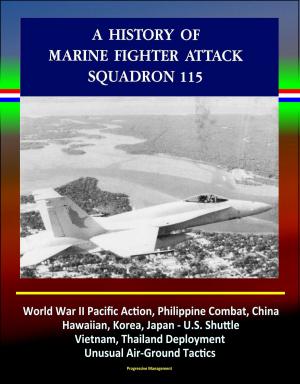The Evolution of Time Sensitive Targeting: Operation Iraqi Freedom Results and Lessons - Desert Storm, Enduring Freedom, CENTCOM Definitions, Future Trends, Adversary Focus on Asymmetric Operations
Nonfiction, History, Military, Aviation| Author: | Progressive Management | ISBN: | 9781310600920 |
| Publisher: | Progressive Management | Publication: | April 26, 2015 |
| Imprint: | Smashwords Edition | Language: | English |
| Author: | Progressive Management |
| ISBN: | 9781310600920 |
| Publisher: | Progressive Management |
| Publication: | April 26, 2015 |
| Imprint: | Smashwords Edition |
| Language: | English |
Professionally converted for accurate flowing-text e-book format reproduction, this study provides unique insights into battlefield targeting.
The nature of US military operations since DESERT STORM has gradually shifted from a conventional force-on-force scenario to one in which US forces likely will counter an adversary strategy of concealment, dispersal, and deception. Over the last decade, airmen at the operational and tactical levels of combat have had to adapt the US targeting cycle to accommodate targets discovered during Air Tasking Order (ATO) execution that cannot wait to be processed under the traditional 24-72 hour ATO targeting cycle. While these targets are sometimes referred to by different names among the services, the highest priority target category as defined above are Time-Sensitive Targets (TST).
The US military's successful joint development of an efficient process to Find, Fix, Track, Target, Engage, and Assess (F2T2EA) emerging battlefield targets coupled with advances in command and control automation with fused intelligence data has resulted in a significant US military capability to counter adversaries' asymmetric strategies. Predominantly from the air component's operational viewpoint, this study will trace the requirement for and evolution of the TST process beginning with the Scud hunt in the first Gulf War. It will summarize the TST progress through Operations ALLIED FORCE and ENDURING FREEDOM, and then analyze the targeting process and results refined during OIF. This analysis will cover broad operational-level results and observations, and where appropriate will note tactical level impacts on operational execution. Finally, the study will address a few of the many TST-related lessons from OIF and provide recommendations to further improve the immediate targeting process execution.
Although the OIF analysis and recommendations are based largely upon draft lessons, doctrine, and/or tactics revisions, many of the draft source documents are already being used in exercises by the USAF and joint community. Other sources for this paper include Congressional testimony, oral histories, briefings, interviews, and personal interaction with the TST Team and immediate targeting process during OIF as a CAOC Senior Offensive Duty Officer at Prince Sultan Air Base, Kingdom of Saudi Arabia.
CHAPTER 1 - INTRODUCTION * CHAPTER 2 - THE RECENT EVOLUTION OF TIME-SENSITIVE TARGETING * Environment * Operation DESERT STORM * Operation ALLIED FORCE * Operation ENDURING FREEDOM * CHAPTER 3 - TIME-SENSITIVE TARGETING IN OPERATION IRAQI FREEDOM * Post OEF Improvements * Background * OIF Force Organization * CENTCOM Target Definitions * OIF TST Execution Results * The Successes * The Problems * CHAPTER 4 - FUTURE TRENDS AND CHALLENGES * Lessons Learned Process * Fixing the Problems * Adversary Focus on Asymmetric Operations * Joint and Coalition Training * CHAPTER 5 - CONCLUSION
Professionally converted for accurate flowing-text e-book format reproduction, this study provides unique insights into battlefield targeting.
The nature of US military operations since DESERT STORM has gradually shifted from a conventional force-on-force scenario to one in which US forces likely will counter an adversary strategy of concealment, dispersal, and deception. Over the last decade, airmen at the operational and tactical levels of combat have had to adapt the US targeting cycle to accommodate targets discovered during Air Tasking Order (ATO) execution that cannot wait to be processed under the traditional 24-72 hour ATO targeting cycle. While these targets are sometimes referred to by different names among the services, the highest priority target category as defined above are Time-Sensitive Targets (TST).
The US military's successful joint development of an efficient process to Find, Fix, Track, Target, Engage, and Assess (F2T2EA) emerging battlefield targets coupled with advances in command and control automation with fused intelligence data has resulted in a significant US military capability to counter adversaries' asymmetric strategies. Predominantly from the air component's operational viewpoint, this study will trace the requirement for and evolution of the TST process beginning with the Scud hunt in the first Gulf War. It will summarize the TST progress through Operations ALLIED FORCE and ENDURING FREEDOM, and then analyze the targeting process and results refined during OIF. This analysis will cover broad operational-level results and observations, and where appropriate will note tactical level impacts on operational execution. Finally, the study will address a few of the many TST-related lessons from OIF and provide recommendations to further improve the immediate targeting process execution.
Although the OIF analysis and recommendations are based largely upon draft lessons, doctrine, and/or tactics revisions, many of the draft source documents are already being used in exercises by the USAF and joint community. Other sources for this paper include Congressional testimony, oral histories, briefings, interviews, and personal interaction with the TST Team and immediate targeting process during OIF as a CAOC Senior Offensive Duty Officer at Prince Sultan Air Base, Kingdom of Saudi Arabia.
CHAPTER 1 - INTRODUCTION * CHAPTER 2 - THE RECENT EVOLUTION OF TIME-SENSITIVE TARGETING * Environment * Operation DESERT STORM * Operation ALLIED FORCE * Operation ENDURING FREEDOM * CHAPTER 3 - TIME-SENSITIVE TARGETING IN OPERATION IRAQI FREEDOM * Post OEF Improvements * Background * OIF Force Organization * CENTCOM Target Definitions * OIF TST Execution Results * The Successes * The Problems * CHAPTER 4 - FUTURE TRENDS AND CHALLENGES * Lessons Learned Process * Fixing the Problems * Adversary Focus on Asymmetric Operations * Joint and Coalition Training * CHAPTER 5 - CONCLUSION















